Team-BHP
(
https://www.team-bhp.com/forum/)
OHC 1.5 VTEC - A City of Joy, from the 2000s
After the economic liberalisation in India in 1991, there has been a drastic change in the Indian car market. Since then, speculations were on as to when Honda would introduce a car in India officially. Even before the company's official entry, Honda brand was so popular among Indian people as we had many imported models on our roads like Civic, Accord, Odyssey, etc. After JDM personal import boom caught the imagination of Indian buyers, by the early-90s there were tons of Hondas in India. Those Indians who desired a sleek Japanese vehicle were able to own one, thanks to the importers who took on local compliance of the cars. It is still possible to see these imported cars lying abandoned in various parts of our country, this is mainly due to the difficulty in sourcing spare parts.
Honda officially entered into the Indian market through a JV with Siel Group in January 1998. City was Honda's first offering to an emerging middle class in India that was desperate for an affordable luxury car. Those were the days when mid-range luxury car buyers wanted something larger than Maruti Esteem but did not want to buy a Ford Escort or Opel Astra. The City was essentially a perfect recipe for brand building exercise in a country like ours. It was introduced here in four variants : 1.3 LXI, 1.3 EXI, 1.5 EXI and 1.5 EXI-S, priced from ₹ 6.3lakh onwards. 1.5 EXI grade itself was available with both manual and torque-converter automatic transmission options.
Being the best-seller in mid-sized sedan segment, City quickly became the backbone of Honda in India. Over and above the features of 1.3, the 1.5 EXI always had tachometer, different stereo, chrome trim around the side windows, blacked-out B-Pillar, digital clock, driver's armrest, wooden-finished centre console, electrically adjustable ORVMs, body-coloured door handles and ORVMs, etc. Later, Honda had added more value to City by bringing few additional convenience and utility features. A new colour called 'Emerald Green' also was introduced in end-1998. The top-end EXI-S variant came fitted with five-spoke alloy wheels, rear spoiler with HMSL, cassette player with four speakers, and a very subtle side skirt. Also, the 'Monte Carlo Blue Pearl' shade was exclusive for EXI-S.
The City was manufactured at Honda's Greater Noida facility in Uttar Pradesh, which had an installed capacity of 30,000 cars per annum. It was ranked the 'best midsize car in initial quality' and the 'most appealing mid-size car' by JD Power and Associates in 1999. City had achieved a market share of 23 percent of the mid-size car market in 1998-99. Originally, the sedan had two engine options when launched in 1998, a 1.3-litre petrol and a 1.5-litre petrol. The 1.3-litre petrol was capable enough to churn out a peak power of 90bhp at 6500rpm and peak torque of 111Nm at 4700rpm. 1.5-litre petrol generated 100bhp at 6500rpm and 128Nm at 4600rpm, and this unit was used to hit 100kph under 11 seconds.
Back in the nineties, owning a Honda was almost like owning a Sony Walkman, a status symbol of sorts in the world of me-too Japanese and Korean clones. The pre-facelift Honda City was not a photogenic car in any manner, but in flesh, the car looked quite smart. Once you had a decent stretch of road, the big hearted City was really an entertaining car to drive. Those who used to drive Esteems knew what it felt like to have a silent, reliable, hardworking engine under the hood. If fuel efficiency was a concern, the Honda City was worth every rupee spent and those people who still complained got explosive performance as a bonus.
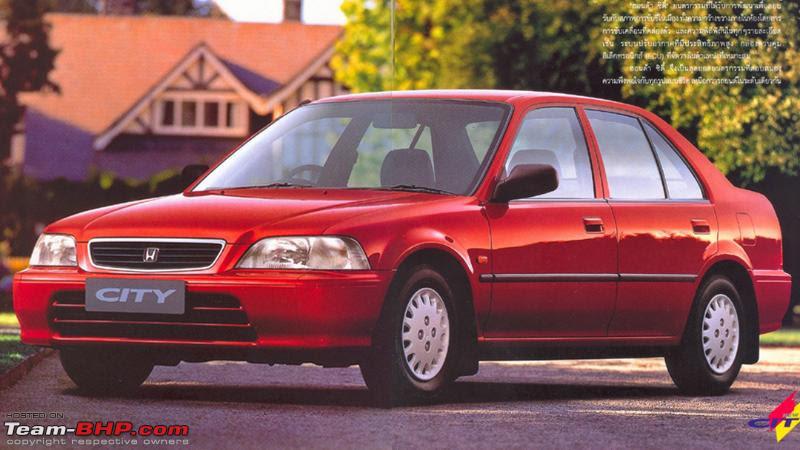
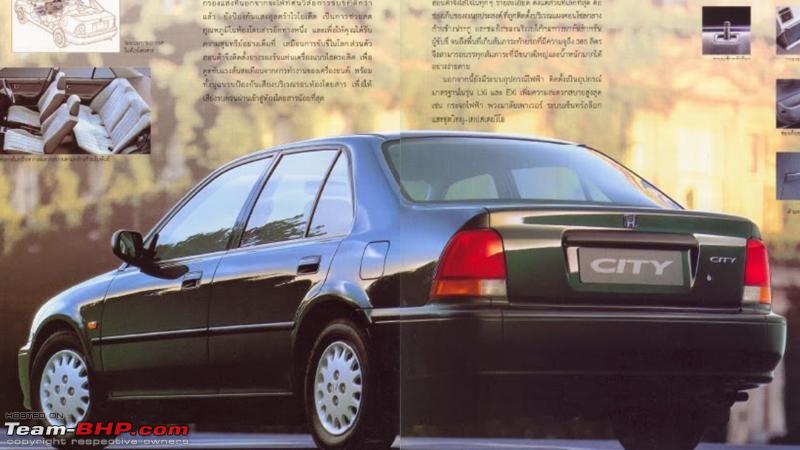
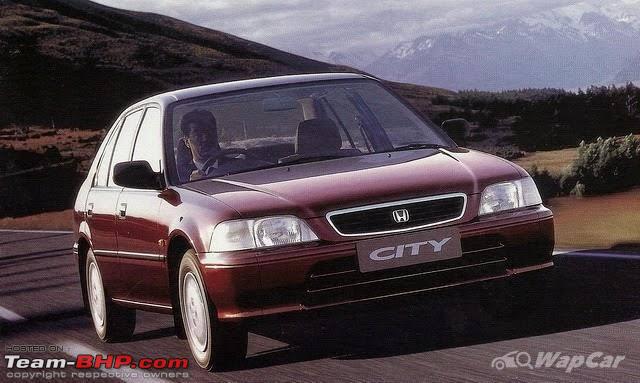
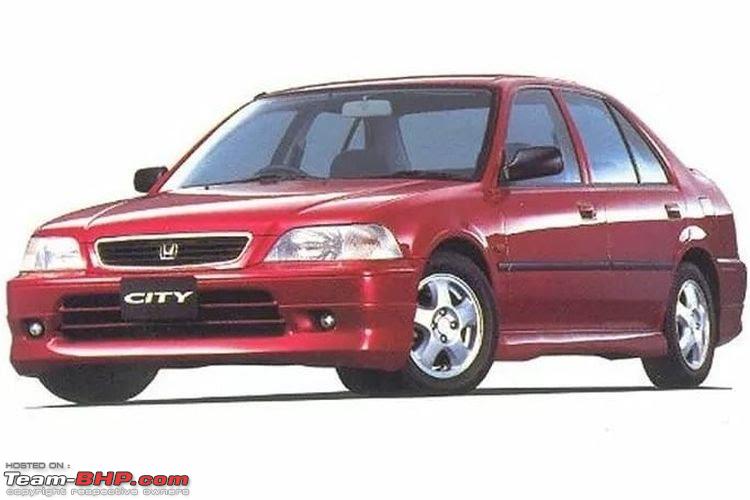 November 1999 facelift :
November 1999 facelift :
While most other manufacturers used to wait for sales to drop before refreshing a model, Honda brought the facelifted City within 2 years when the model was selling like hot cakes. The main areas of change were with the interiors, stereo and rear suspension. Along with this, the front and rear appearance also were modified, with a clear-vision headlamp console, raked hood, wider bumper with fog lamp slot and broader radiator grille. At the rear, City recieved wraparound taillights, the trunk lid got redesigned and the rear bumper also got redesigned. This resulted in a change of the overall length, adding 45mm, bringing it to 4270mm. Prices reflected an increase of approximately 2-3 percent over the prices of the older model.
The facelifted City was originally released in four variants :
• 1.3 LXI, priced at ₹ 6.3lakh ex-showroom
• 1.3 EXI, priced at ₹ 6.8lakh ex-showroom
• 1.5 EXI, priced at ₹ 7.5 lakh ex-showroom
• 1.5 EXI AT, priced at ₹ 8.0lakh ex-showroom
It was sold here in seven different colours options such as Frost White, Sapphire Silver Metallic, Heather Mist Metallic, Maharajah Gold, Emerald Green Pearl, Inza Red Pearl and Adriatic Blue Pearl.
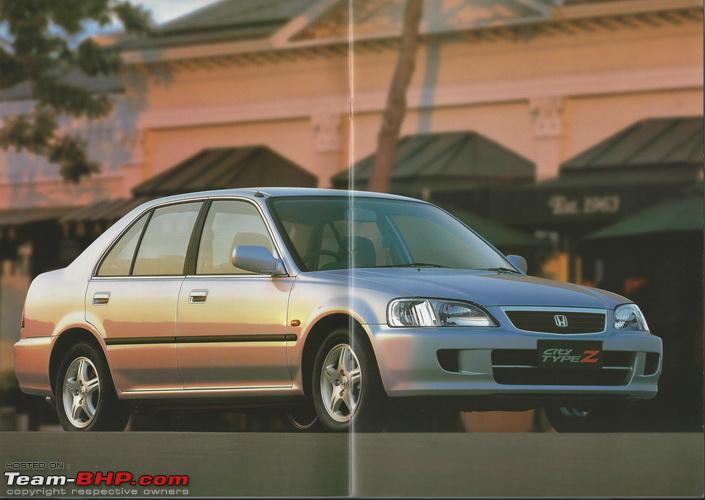
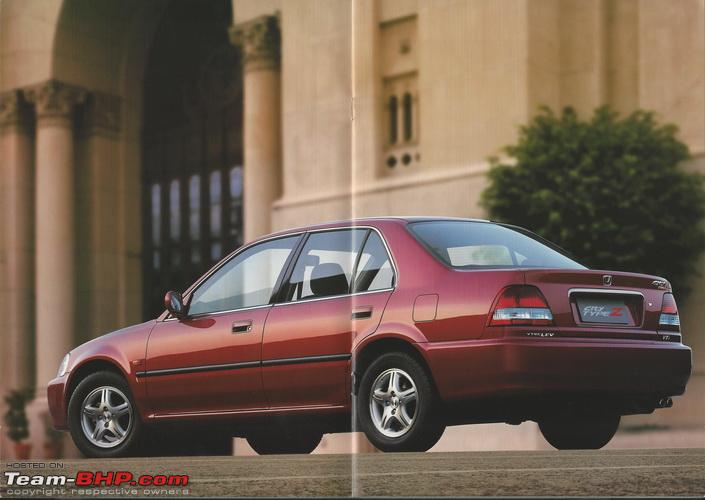
August 2000, the entry of a legend
Back in the day, Honda was the one and only car manufacturer who was not shy of giving India hi-tech products. The Honda City 1.5 used to be a great car in the Indian context, basic 1.3 variants also were decent in terms of performance and refinement. Honda was internationally a petrol passenger car manufacturer, they had no heavier automobiles like trucks or buses. They weren't even interested to know about diesel technology. But Honda thought to fit the Indian-spec City with the 1.5-litre engine featuring the variable valve timing and lift electronic control system technology which was featured on S2000 as well as the NSX. The performance of the regular City 1.5 was talked about in the superlatives and the VTEC variant was expected to be something else.
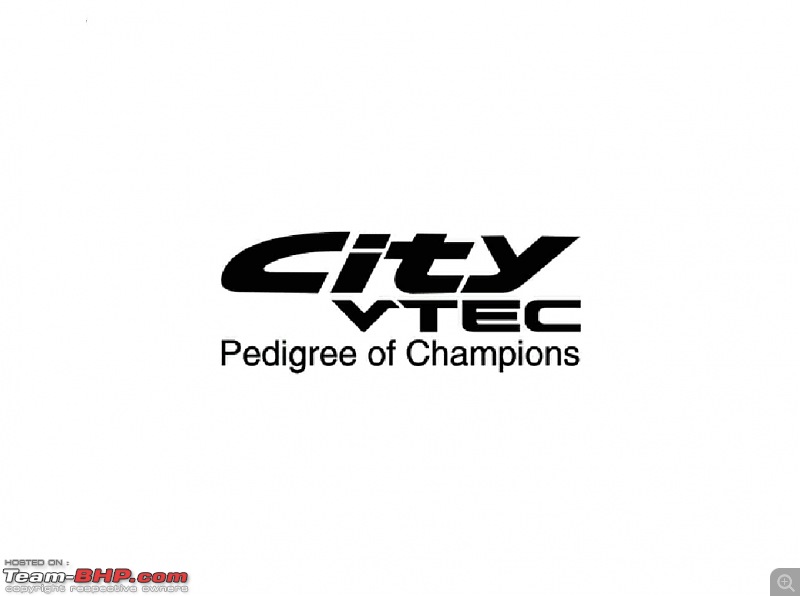
India's hardcore car enthusiasts tasted VTEC technology for the first time in August 2000. Priced at around ₹ 9.5lakh ex-showroom, the VTEC variant was positioned as the top-spec variant of City. For people who drove Lancer and Ikon 1.6 till then, the Honda City VTEC was a fresh breath of air. With Honda's VTEC technology, the City was one of the most technologically advanced car being sold in the country at that time. Mitsubishi had launched an SFX variant of the Lancer in January 2000, but it never attempted anything under the hood which was what Honda built upon in the City VTEC. Since the 1.5 VTEC variant was almost ₹ 90,000 more expensive than the regular 1.5 EXI, people actually felt a bit sceptical paying so much extra for a technology that had no outward physical manifestation.
A Honda City VTEC being tested by BS Motoring in August 2000. Sorry for the poor quality image. 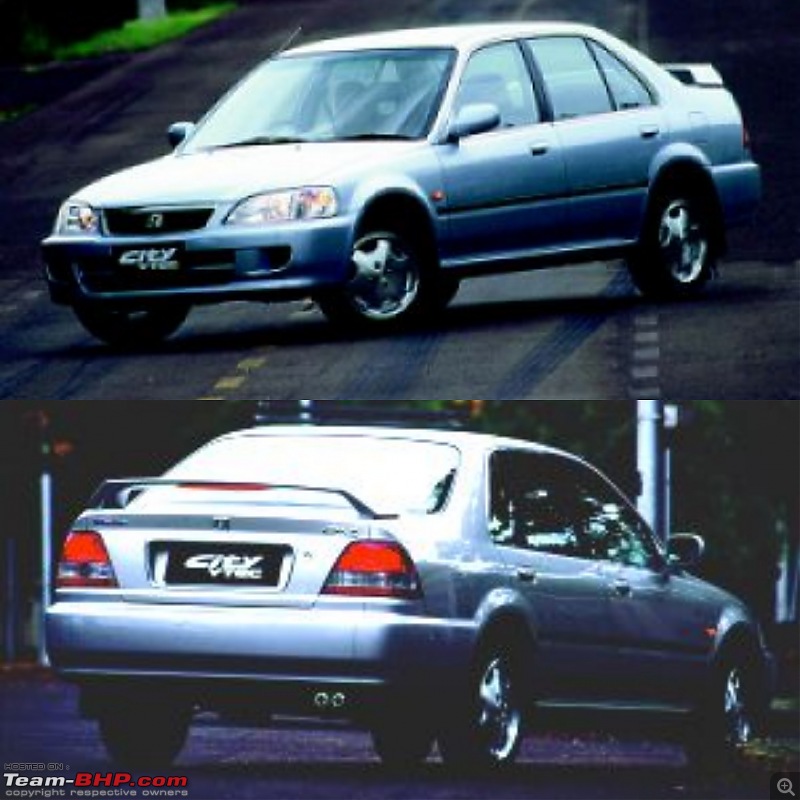 EVERYTHING ABOUT THE CITY 1.5 VTEC : Exterior and Interior :
EVERYTHING ABOUT THE CITY 1.5 VTEC : Exterior and Interior :
The Honda City VTEC was quite understated. Viewed front-on, it presented the identical handsome lines of its siblings, the City 1.3 and the 1.5. It had the same raked and aggressive clear lens and multi-reflector headlamps, the same sleek hood climbing up along two diverging grooves to the large windshield, the same three-piece bumper assembly. Certain sporty accents appeared on the VTEC-engined sedan with the double barrelled 'shotgun' tailpipes, trunk spoiler with high-mounted stop lamp and chrome-garnished license plate slot being obvious ones. Apart from the VTEC legend on the engine cam cover, the only other palce where it appeared was below the City badge on the boot lid. Of course, the VTEC badging, worn quietly on the boot lid, promised much to automobile enthusiasts.
Would you like to see a low-slung Japanese sedan on the Indian roads again? 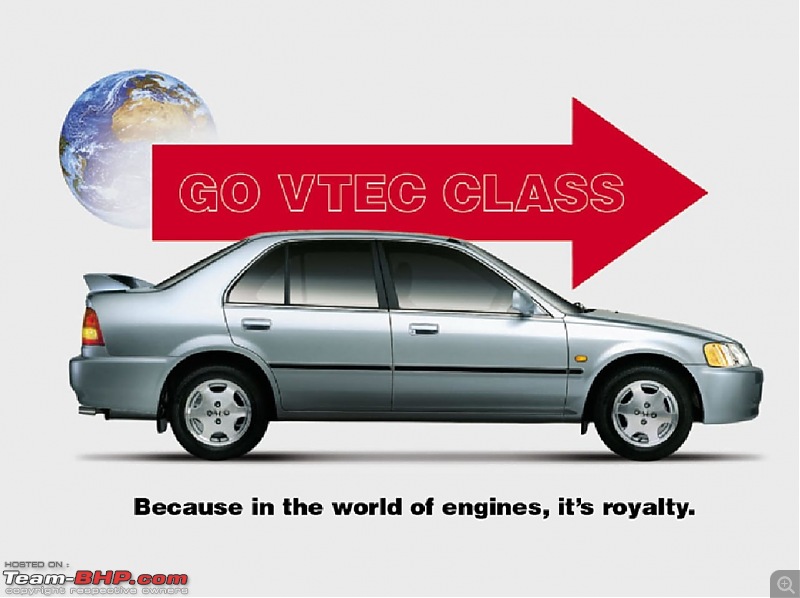 The car was a good-looker from the rear too. Look at the 'VTEC Special' spoiler, double barelled tailpipes, etc.
The car was a good-looker from the rear too. Look at the 'VTEC Special' spoiler, double barelled tailpipes, etc. 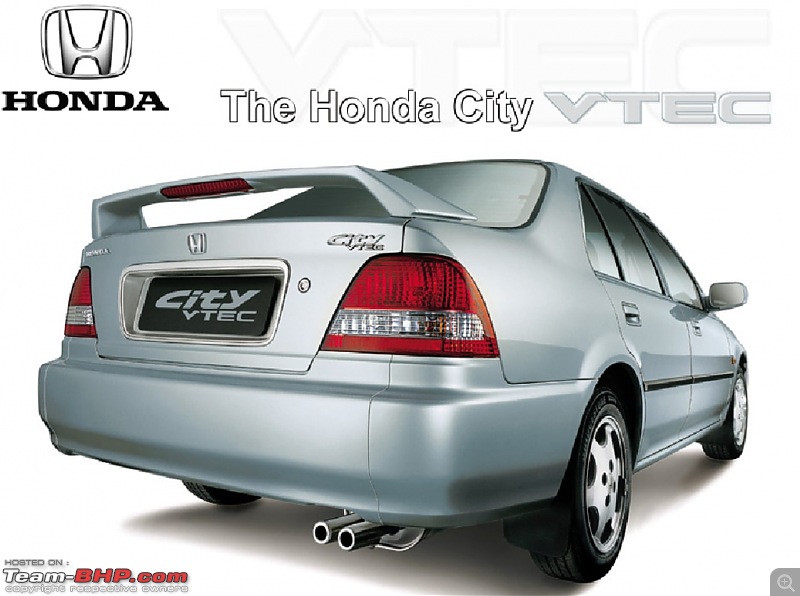
The 14-inch six-spoke alloys originally wore Bridgestone's 65 aspect ratio S322 rubber which in the overall scheme of things got gearing to near enough the same as the non-VTEC City 1.5, but the dynamic ability was sharpened. Inside, the cabin gained character, the black plastics were spruced up with the incorporation of brushed metal accents on the centre console, the air-con vents and the front power window controls. A high-end Alpine-branded audio system, better fabric upholstery, see-through headrests, a leather-wrapped steering wheel and gear knob brought an additional sigh of relief into the interior package. The City's sporty nature was taken to newer heights in the design department, thanks to cosmetic enhancements.
Inside, the overall layout was typical Honda. Everything felt good to look at and were clearly laid-out too. 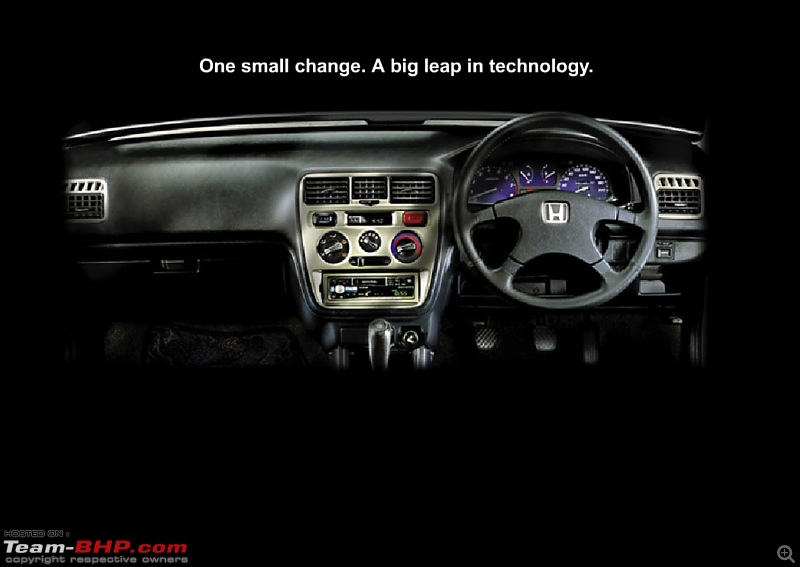
Legroom at the rear was quite decent and two seatbelts were standard for the back seat. City being a low-slung sedan, rear seating position was too low for the passengers, and this compromised comfort also to an extent. Due to the same reason, egress and ingress was very difficult for elderly people. Many people expected City VTEC to have improved interiors from the regular 1.3 and 1.5 variants, but they were sorely disappointed when the car came out. For the fact to be said, City's interiors were nowhere close to that of the Opel Astra.
This was a car that cradled the driver in a low-slung sports car seat. The metal-finished accents lent it a great degree of chic that most owners loved. 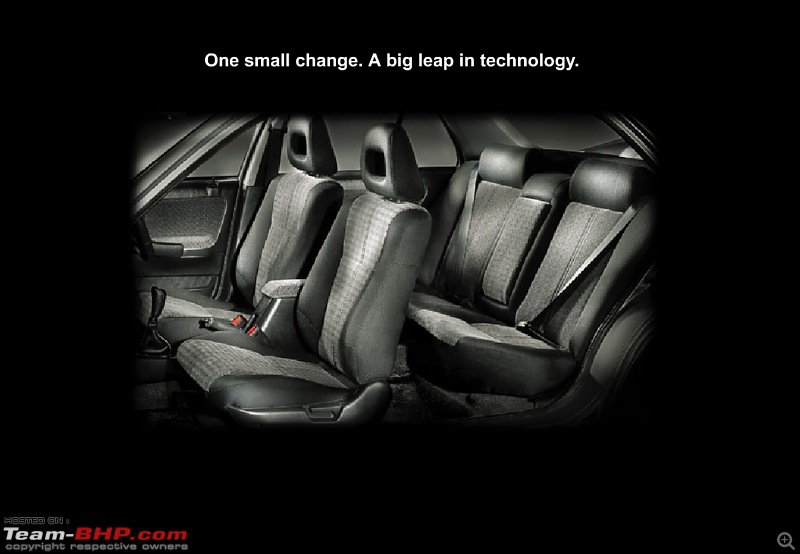
Headlining was the hanger type and not the moulded version that we used to see in cheaper hatchbacks and sedans. Driver's seat height adjustment and tilt-adjustable steering were not provided. Like all other variants of City, this 1.5 VTEC also had three-piece bumpers. It is said that these bumpers were made in three seperate pieces to allow easy shipping from Japan. In case if the bumper gets any scratch or dent, user can just buy a replacement piece from the workshop rather than waiting for a whole new bumper to arrive.
Shown in the picture is a City VTEC with three-piece rear bumper. Pre-facelift cars also had the same kind of bumpers. 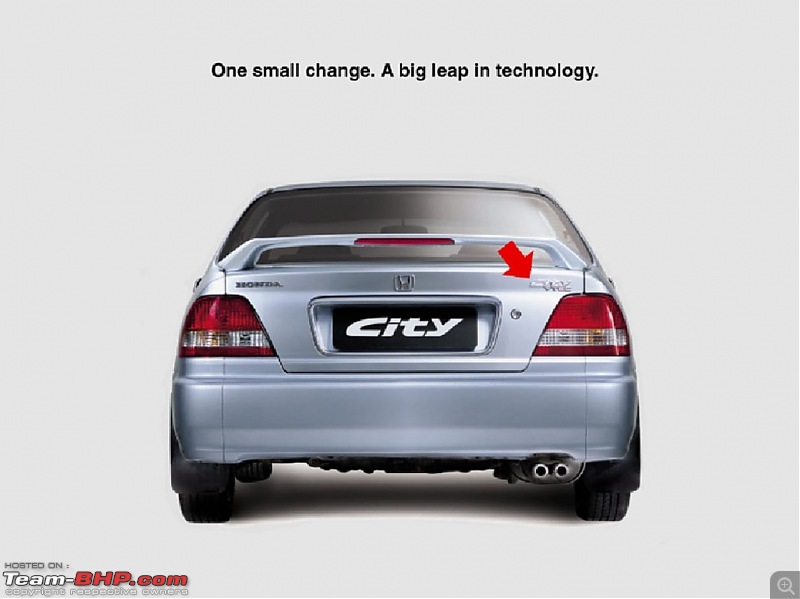 Suspension and Ride Quality :
Suspension and Ride Quality :
The City was a car with a bare-basic rear suspension setup. With an independent strut with trapezoid link assembly, the vehicle fall short of the ride and handling package offered by the most of the competition in its class and even some cars in the one-lower segment. Ride was on the firm side and this was not suitable for those who were used to the plush ride of Ford Escorts and Daewoo Cielos. What saved it to an extent were the superb wheels that came as part of the package, the tyres showed absolutely no signs of traction loss, except when they were called to work at speed and handling parameters beyond the abilities of the suspension setup. The standard, stiffly damped units seen in all the Honda Citys produced in India were the same units sold as the sports option in Thailand.
The basic four-link suspension at rear. Picture from Autocar India's August 2000 issue. 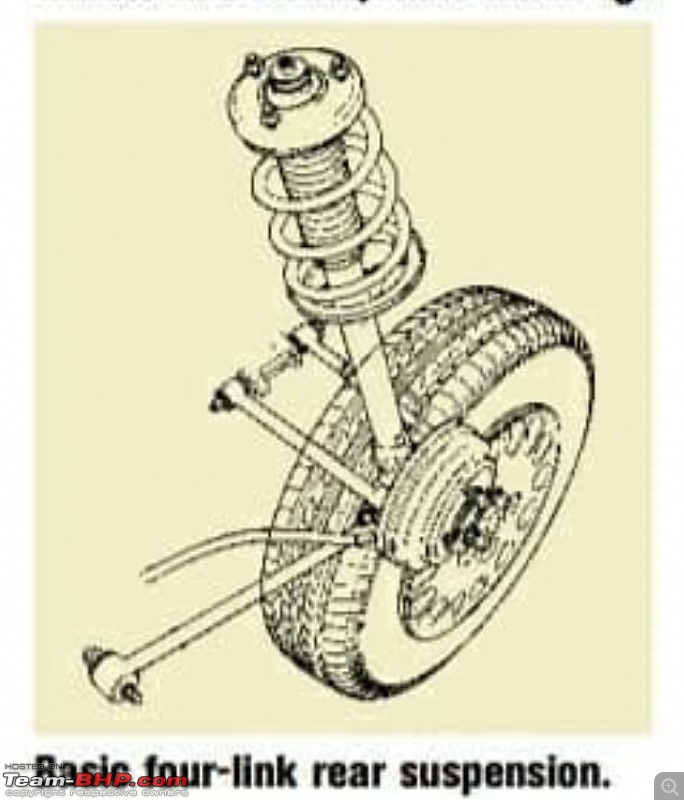 Performance and Handling :
Performance and Handling :
If you thought that the fifth-generation City is smooth, then you have to try the first-generation City VTEC too! What greets us when we open the hood is a SOHC, 16V four-cylinder 1.5-litre VTEC mill that generates 106bhp at 6800 revs and 132Nm of torque at 4700 revs. Sounds poor by today's standards, but how about hitting 60kmph figure in just 4.85 seconds, a 0-100 kmph in 10.35 seconds, and a fantastic mid-range that promises a passing speed (80-120 kmph) figure of 8.25 seconds? For the truth to be told, this particular engine did a good job of saving all the fun up until 5000 rpm, post which, the VTEC KICKED IN YO! The good part was that the increase in torque was right across the rpm range, it went up by about the same 4Nm at the corresponding rpm.
A closer look at the engine bay. Picture from Autocar India's August 2000 issue. 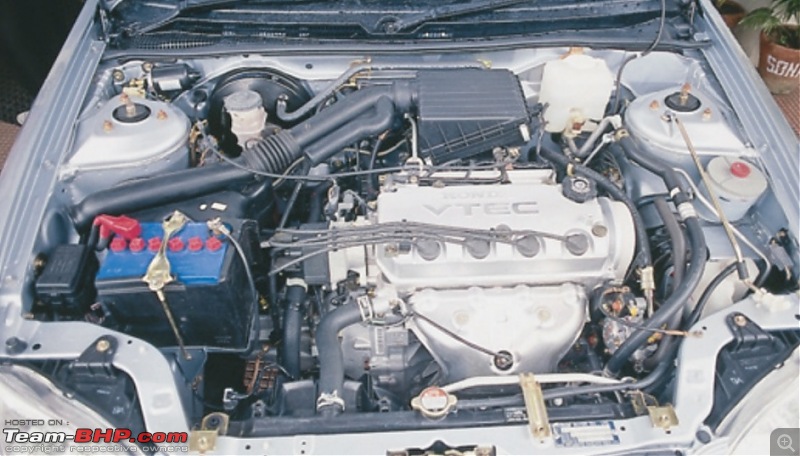
Another interesting thing to note here is that this same engine had a peak power output of 120bhp in most Asian countries and the unit was detuned to make it compatible for the quality of fuel available in India. Gearbox remained same as that on the non-VTEC City 1.5. Despite everything being nearly the same, the gearshift quality was somewhat of an improvement on the City 1.5. Brilliance of the VTEC technology hits us with full force when pushed hard, 0 to 100kmph time of under 10 seconds was top class back then, but engine hit the rev limiter just 2kmph short of the 100kmph mark in second gear. This begged a shift from second to third gear just before 100kmph. If another fraction of a second was gone, the VTEC would have beaten the times of a Mercedes Benz E240 (W210). The VTEC valve gear contributed to a greater increase in mid-range thrust which was where the Indian motoring was mainly focused on.
Data from the 0-100kmph test conducted by Overdrive in September 2001. City VTEC was ranked third position after W220 S-Class and W210 E-Class. 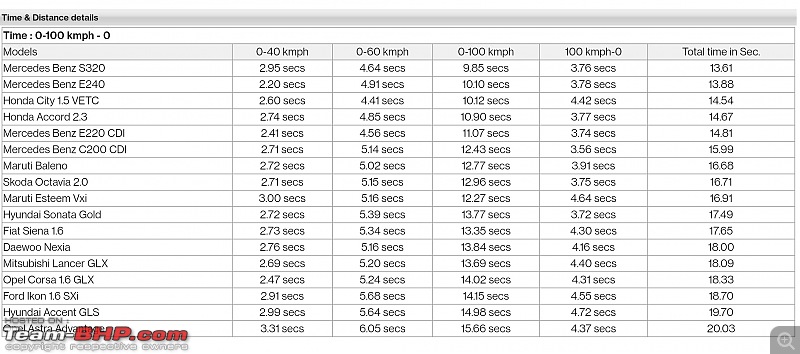 What is VTEC?
What is VTEC?
Most car manufacturers used to offer high tech engines with engine control modules that were able to vary the valve timing, but there were none which had ability to control the lift of the valves at the same time. Honda through various R&D activities, developed a valve train mechanism called the variable valve timing and lift electronic control system (VTEC). With this mechanism, it was possible to simultaneously change both the timing and the degree of lift for intake and exhaust valves.
Basically, this mechanism was very simple in design and excelled in efficiency and reliability. It was possible to maximise power output in both the high and low rpm range or increase economy in the high or low rpm range. Different combinations of the above also can be achieved by varying the profile of the cam lobes on the camshaft of engines having four valves per cylinder. Before City, Honda had put many variants of this technology into production.
SOHC VTEC was the one used in the Honda City. One of the intake valves opened normally while the other one opened only slightly during normal operation. In the Honda Insight, only one of the intake valves was in operation under normal conditions while the other one remained shut and opened only when needed. The intake valve which opened with a low lift began opening higher when the engine control module sensed the need for power or when the engine was operating at higher rpms.
This switch was achieved by having a mid rocker arm and a third cam lobe. These multiple cam lobes per cylinder provided one valve timing and lift profile at low speeds and a different cam lobe profile at high speeds. The switch from one profile to another was controlled electronically and was selected by monitoring various inputs like current engine speed and load. The mid rocker arm was equipped with a supplementary spring with a lost-motion function for reducing the amount of arm play at low speed rpm range, and made the valve movement smoother in high speed range.
When driven at high rpm, it was recognised as such by the electronic control module, then a piston moved right across the three rocker arms. As a result, the primary, secondary and the mid rocker arms were linked together and the three rocker arms were moved as a single unit. The motion of these linked rocker arms was regulated by the cam lobe the profile of which was made for high lift and the valve timing of this also was set for high operations. The movement of piston which linked rocker arms was hydraulically made, the pressure created by a solenoid was activated by the electronic control module.
Due to the demands made by this mechanism, Honda adopted long lasting cast steel camshafts and light high strength thin stem exhaust valves. Though the system adopted in India was not geared for high performance, a 1.6-litre Honda production engine with VTEC technology produced about 160bhp, or specific output close to 100bhp/litre. In the case of City VTEC's engine, the technology enhanced both intake and combustion efficiency throughout the entire rpm range. The final result was an effortless city driving, extra power for highway driving, fuel efficiency and lower emissions.
Competition :
1. Mitsubishi Lancer - After the Marutis and the Honda City, Mitsubishi's Lancer was the third Japanese entry on four wheels to the Indian roads. It was a trifle too late in coming but lost nothing much to its competitors like Daewoo Cielo, Opel Astra and Honda City. Lancer was actually built via a technical collaboration and not through the usual joint venture route. The SFX variant, with its great looks, solid, stunning colours and body addons had tremendous response from car buyers who preferred to stand apart. While the Lancer SFX additionally offered a better ride and handling package, the City VTEC had some race-bred horses flowing through its revs.
A pre-facelift Mitsubishi Lancer SFX in Storm Yellow shade. 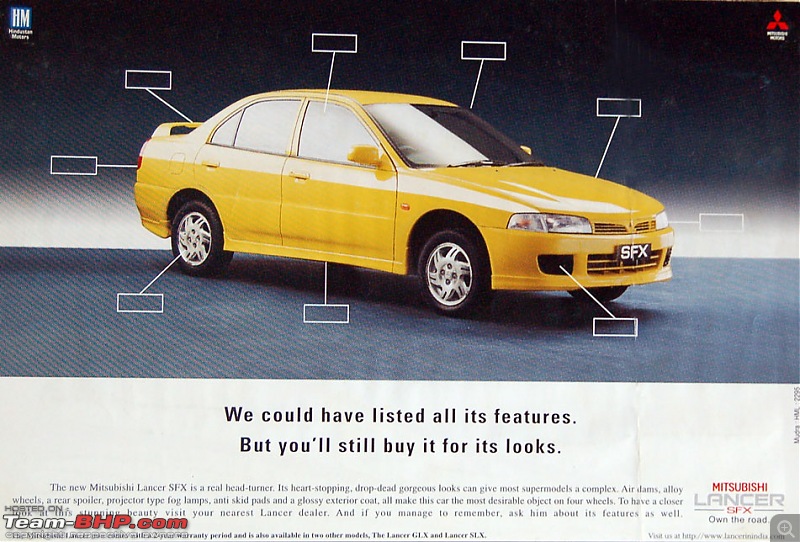
2. Maruti Baleno - The Baleno was the first assualt from Maruti's side on the premium sedan category where it was pitted against Opel Astra, Honda City and Mitsubishi Lancer. Economics in this segment made no sense to Maruti, to which a low-volume, high-import content build was anathema. The sedan was perfectly tuned to suit India's driving conditions with emphasis on refinement, fuel efficiency and driveability. It was a well-balanced combo of clean looks, classy interiors, precise handling and comfortable ride. While the City VTEC was hugely overrated, the Baleno just died a slow and painful death in our market.
Maruti Baleno, one of the many sedans that was always underrated. 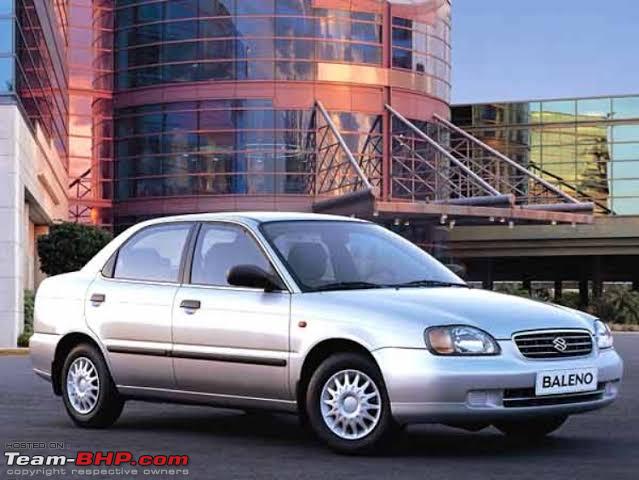
3. Opel Astra Club - Astra wasn't the quickest or the most exciting car back then, but it was a well-built, safe highway-muncher, and with the right accessories, used to turn many heads. The top-of-the-line Club variant was equipped with electric sunroof, CD changer, leather seats, front seat back pouches, rear sunblind, etc. Apart from these, it used to have digital trip info display, rear spoiler, tachometer and emergency warning system also. At the heart of petrol-powered Astra Club lied a 1.6-litre Multiport 16 NZR engine mated with a 5-Speed manual gearbox. This engine option was released when Euro-2 emission norms were made stricter in India. Before this, Astra used to have a 1.6-litre 16LZ2 unit with similar outputs.
Opel Astra, this used to be the status symbol of every rich family during nineties. 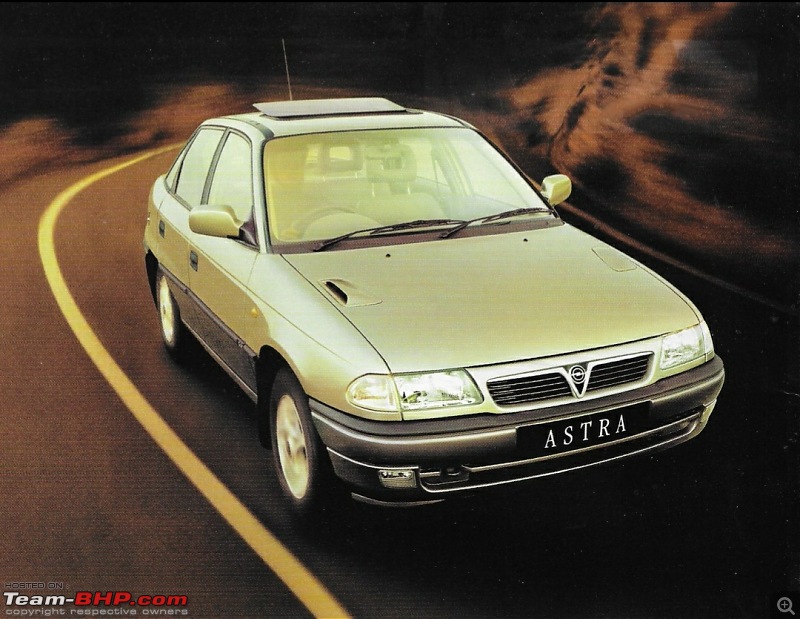
4. Daewoo Cielo/Nexia - The entry of Daewoo into the Indian market was heralded as a milestone for the automobile industry. This was because it was the first multinational car brand to challenge the might of market leader Maruti. Buyers who had no other option besides the Maruti Esteem in mid-size segment until then, rushed to buy Cielo. In 1999, Daewoo discontinued GLE and GLX trims of Cielo and replaced them with Cielo Executive and Nexia. Basically, the Nexia was a more powerful version of the Cielo. It had more powerful 1.5-litre I4 NA petrol engine producing 93bhp and 132 Nm. A chiptune from RS Chip Tuning was capable of moving the output up to 102 bhp and 149 Nm.
Cielo also was considered as a luxury car in India. Nexia failed to stand in the market for long and was discontinued when Daewoo left India in 2002. 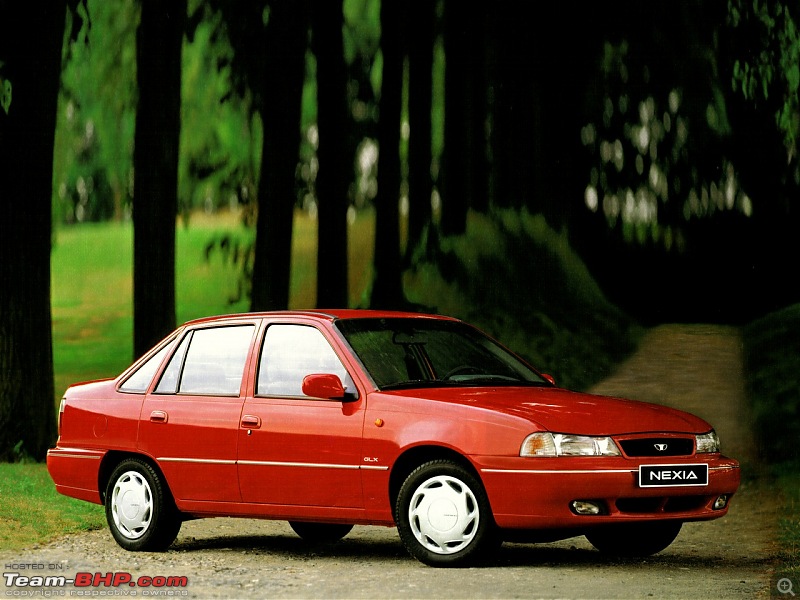
At the time City VTEC was launched, it had target customer base like the way Camry Hybrid has now. High networth individuals who wanted an upmarket sedan. It was out of reach for enthusiasts. Only the arrow shaped City (after dolphin shape) in mid 2000s became accessible to enthusiasts - thanks to Manmohan Singh's era economic liberalisation benefits. However turbo diesels and turbo petrols exploded on the scene by this time and VTEC was not such a big deal by that time. In that sense, I feel enthusiasts in India didn't have much to do with VTEC. Honda India in general has not been very proactive in our market and it is hardly on the radar of any enthusiast with their CVT portfolio.
Quote:
Originally Posted by androdev
(Post 5176995)
. In that sense, I feel enthusiasts in India didn't have much to do with VTEC. Honda India in general has not been very proactive in our market and it is hardly on the radar of any enthusiast with their CVT portfolio.
|
well i find that hard to believe, as we had a whole mammoth of a thread on team-bhp itself only on the VTEC VS other cars. True Honda never gave us their true DOHC VTEC engines, but the SOHC VTEC on the Indian SX8 was truely a gem. The Indian VTEC when it was launched was the highest revving engine in its class and had the most power to weight ratio at the time. Guys have been tuning and driving VTECs for more than a decade now, Thank god Honda gave us the SOHC VTEC engine atleast !
Even in modern times, the SOHC VTEC is still a gem of an engine. Yes, the SX8 is a aged chassis with very minimal safety tech, but the car can be a monster when built by the right people.
The present Indian National touring championship car is a Built in Bangalore honda city VTEC with a 1.5 SOHC VTEC engine. It holds its pace against modern cars like the VW Vento and Polo (Running 1.8 TSi with Sequential race boxes)
What I remember of the old Honda City was its Hyper-16 valve engines and the front bumper that would come as a 3 piece unit viz. corners could be replaced separately. While Maruti stuck to L, V nomenculature for its trims then, Honda had L and E. One normally associates E with the lowest trim, so I'm surprised why Honda peristed with that.
I haven't experienced the old Honda City much but do remember travelling in one in the rear seat for 20kms. I liked the way the car rode.
Quote:
Originally Posted by Shreyfiesta
(Post 5172246)
the 1.5 EXI always had tachometer, different stereo, chrome trim around the side windows, blacked-out B-Pillar, digital clock, driver's armrest, wooden-finished centre console
|
Here is a pic of the 1.5EXi inside from the brochure, and some pics courtesy bhpian @ByDesign
From the brochure 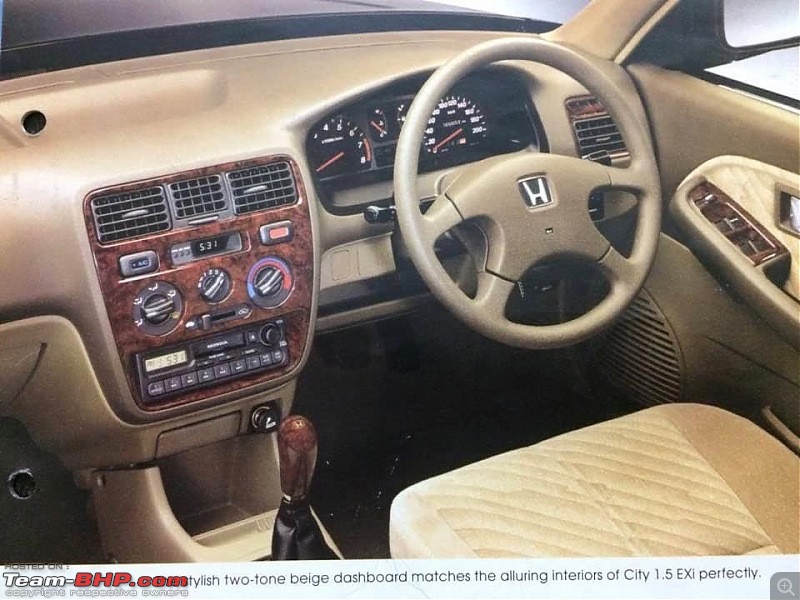 Emerald Green Honda City 1.5EXi sample pics
Emerald Green Honda City 1.5EXi sample pics 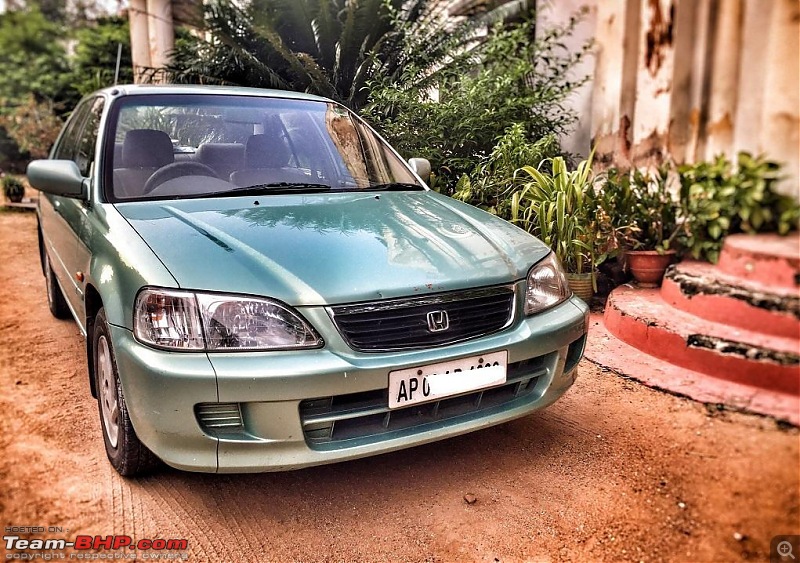
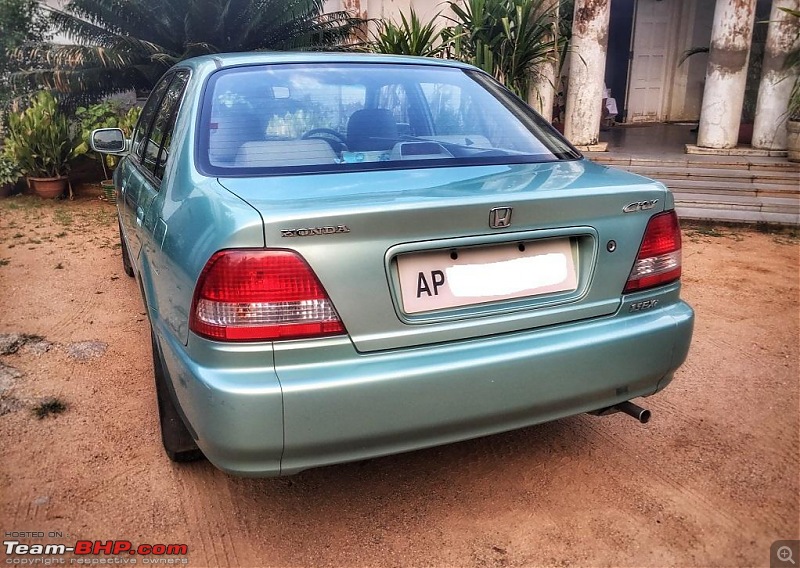
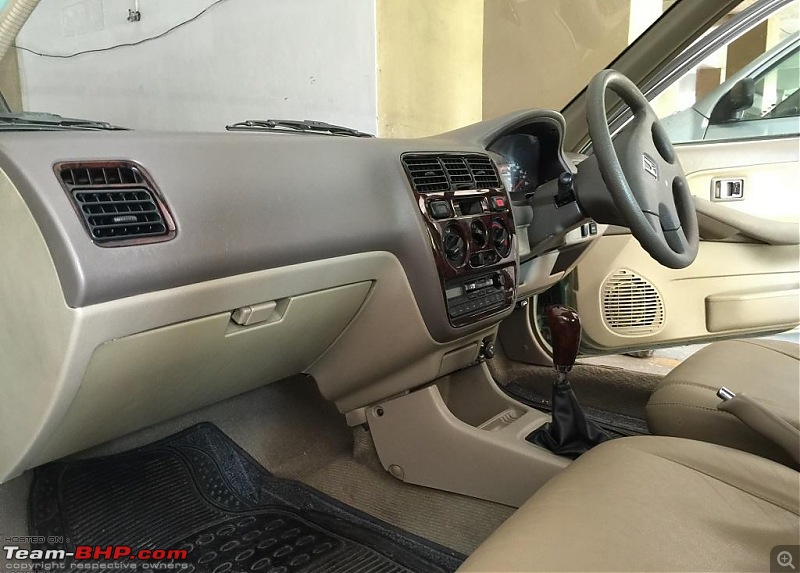
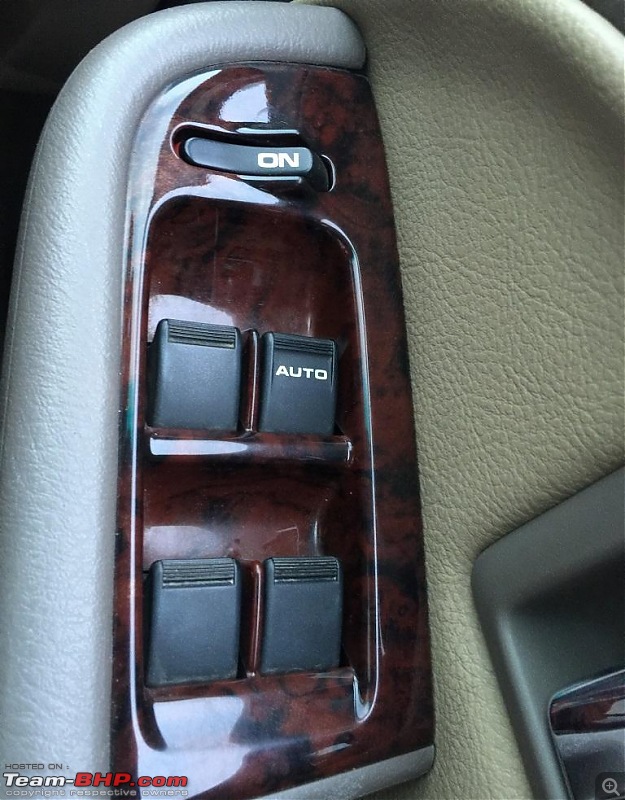
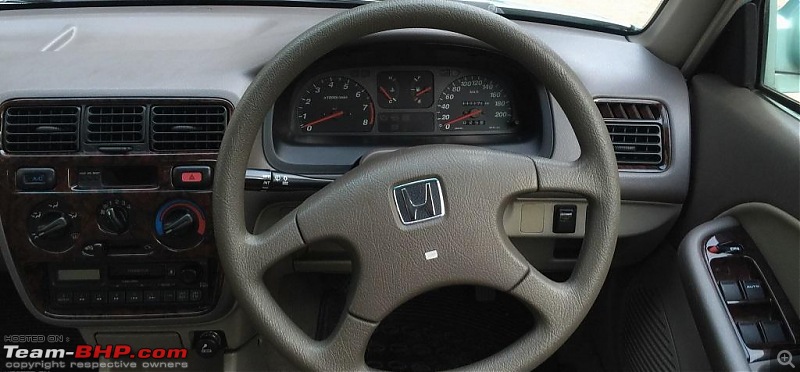
Another pic featuring those alloys that came with the old Honda City top trim
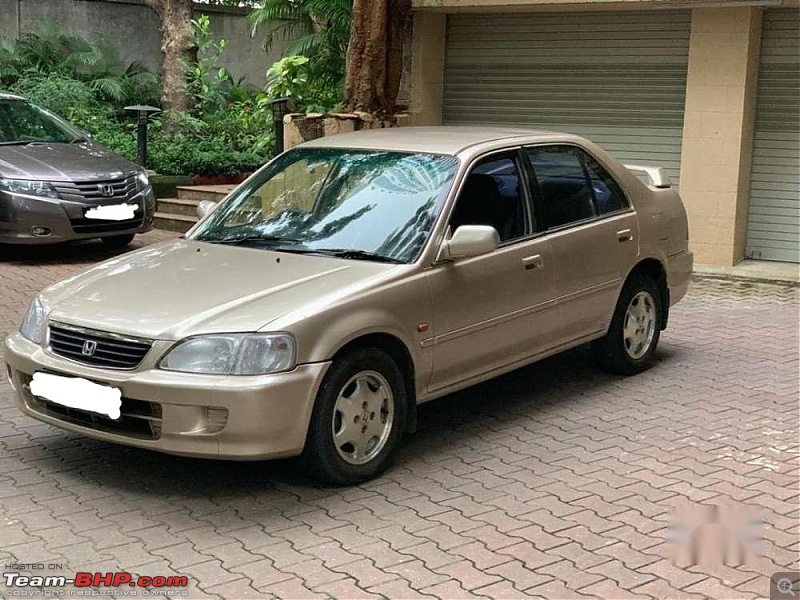
Quote:
Originally Posted by speedfreak
(Post 5177000)
well i find that hard to believe, as we had a whole mammoth of a thread on team-bhp itself only on the VTEC VS other cars. True Honda never gave us their true DOHC VTEC engines, but the SOHC VTEC on the Indian SX8 was truely a gem. The Indian VTEC when it was launched was the highest revving engine in its class and had the most power to weight ratio at the time. Guys have been tuning and driving VTECs for more than a decade now, Thank god Honda gave us the SOHC VTEC engine atleast !
Even in modern times, the SOHC VTEC is still a gem of an engine. Yes, the SX8 is a aged chassis with very minimal safety tech, but the car can be a monster when built by the right people.
The present Indian National touring championship car is a Built in Bangalore honda city VTEC with a 1.5 SOHC VTEC engine. It holds its pace against modern cars like the VW Vento and Polo (Running 1.8 TSi with Sequential race boxes)
|
I agree with your post. I was referring to brand new car purchases. No enthusiast was buying cars like City vtec, Astra club etc - they were too unaffordable back then. Even the dolphin shape City was selling a lot of non-vtec models compared to vtecs. The scenario is very different with the used car market. My post was more of a comment on timing of VTEC and purchasing power trends of enthusiasts. I would say Polo TSI+DSG is the true VTEC-moment of our market - where the affordability, availability of tech and ecosystem for mods coincided.
Awesome thread with tons of details! Of all the cars I've owned & sold, the one I miss the most is my 2003 City Vtec. Mad, insane, ballistic engine + beautiful steering + amazing fun <100 kmph (scary at 120 kmph and above). The Asian taxi body, interiors and suspension were fine when introduced in 1998, but it sure felt cheap & basic in the years after. I bought her just for the engine. The car was simple, yet overengineered. In the ~70,000 km I had her, I maybe had a small problem or two. It just went on and on.
The City Vtec was the default choice for petrolheads. In my opinion, the Mitsubishi Lancer was overall the superior car (we owned one of those too), but it just didn't have that crazy engine. Best part for enthusiasts was, the Vtec's production ended in 2003 and shortly after, the new boss -
1st gen Octavia vRS - arrived. The vRS was next level.
Roads were so much emptier in the 90s & early 2000s. If you had a 100 BHP car, you were pretty much the fastest on the road, unlike today where even vans get 180 BHP! We had a lot more fun then than enthusiasts of today in their 150 - 300 BHP cars.
Turn the volume knob up and enjoy the symphony :D. 106 wheel horsepower after 70,000 km of redlining!
https://www.youtube.com/watch?v=HdsCul-rtmE
Some pictures for your viewing pleasure:
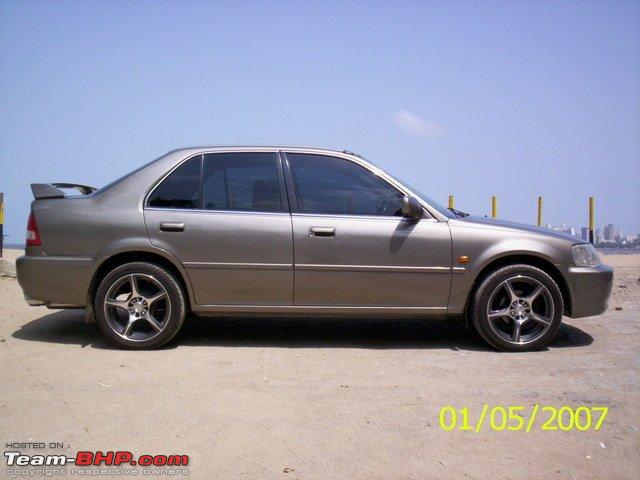
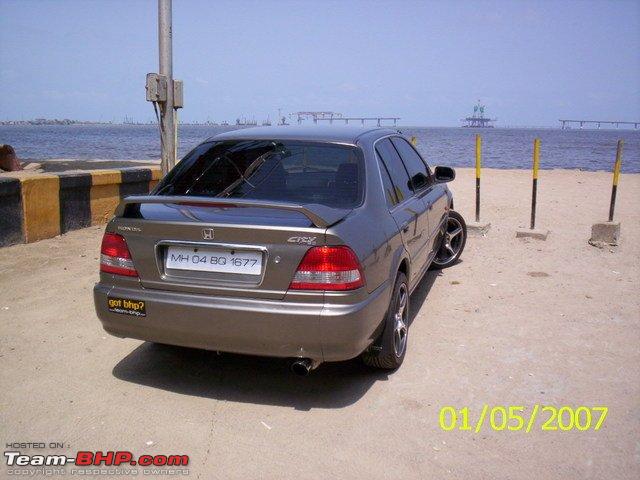
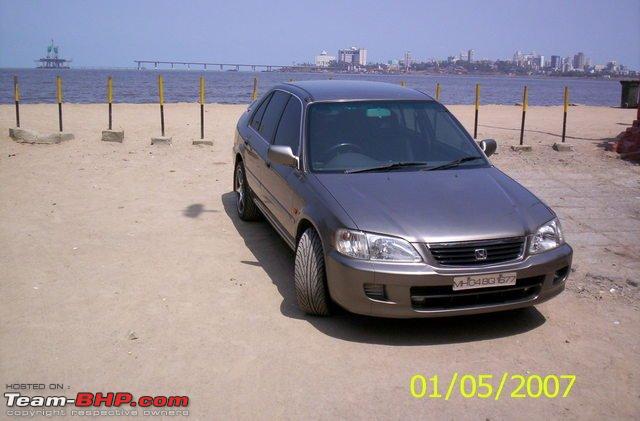
We had a 1.3 in our group in college, and you know how some cars are called magnets for girls? Kinda derogatory. This car, however, was called the d!(k magnet by everyone in college. This guy was very popular, unfortunately only with guys..... :D, cos of the car. In fact, I went out looking for a 1.5 when I first wanted a sedan.
Which is why pictures like these make one sad. Found rotting away a days back:
What an amazing thread to an equally amazing car. In the 10 years I spent with my OHC Vtec, the car hadn't disappointed me once. It had its shortcomings in the form of handling like a boat on stock tires, but once that is sorted out with the right size, it doesn't fail to put a wide smile on your face every single time you floor the gas pedal. The power delivery was linear but it screams all the way to 7200 rpm. Never seen such a high revving engine in regular commuter cars.
The OHC Vtec, like the RD350 and RX100, has a permanent name in the Indian automotive scene.
Wow, great thread and can't come at a better time, just last week i was reading about a comparison of current gen City vs 1st gen one on instagram by a sort of reputed page and they got their facts either wrong or were in the dark of VTEC's existence.
They compared the power figures of non-VTEC 1.5 to today's car which is VTEC which is totally misleading.
I remembered the 108 hp figure from my memory as i was around 7 years old when we got our non VTEC car but was just as enthusiastic as i'am today and used to argue with my dad to get the VTEC but he used to say it is just 7-8 hp more for about a lakh of difference and visually worse looking interiors (Sort of cheap looking wooden vs even more cheap looking silver inserts on the dashboard).
The fact of the matter is engine technology has not improved by leaps and bounds in these 20 years other than the fact that the trend has moved towards turbos (rightly so) and they have been made to make a broader spread of power and less lag, other than that the power figures and even most of the internals for the best of naturally aspirated engines and engines in general has not improved by leaps and bounds since the early 90s (30 years now), unlike say mobile phones whose CPUs and GPUs are seeing huge exponential growth year on year.
Like Honda introduced its performance oriented naturally aspirated 1.6l engine which produced around 160bhp in early 90s and India and City/Civic's Indian versions till today never got its equivalent or better.
In the same manner the lower end (in Honda's engine range) i-VTEC on the City today makes 120 bhp and even the 1st gen's VTEC internationally made 120-130 bhp and was detuned for our poor quality fuel then, had the same engine been introduced today, i see no reason for it to make the same power as today's City even taking into consideration the fact that these engines have to be BS6 compliant as that engine in its highest configuration made 130 bhp which is well within the safety margin.
Also, it was not that that engine lacked in refinement or the spread of power was much inferior, the new gen's engine is barely incremental in its improvements, if any. (Even this gen's engine is very closely related to the 2nd gen's i-DSi engine and is a VTEC and somewhat improved version of that and that engine was introduced back in 2003)
So you see that power comparison between the 1st and 5th gen was sort of misleading but i would't have explained in such detail on instagram and to its ignorant crowd. :p
So to get the facts correct in my brain i googled about the first gen City last week, and surprisingly there were zero good articles about that on the internet, wikipedia hardly had anything, even the best of magazines had terribly basic and sometimes even wrong articles presumably typed by uninterested or non-enthusiastic interns as the first gen car was genuinely a sort of big deal for the Indian car market and was commercially successful too.
I'am not being condescending to those car magazines as at that time their reviews and articles/comparisons were highly exhaustive, detailed and written by true enthusiasts but that knowledge was lost to time and was not made available on the internet.
This thread changes that successfully and is pretty much everything you need to know about the car and the writeup and small details are very well done and that is why the car enthusiast community on team bhp is inferior to none anywhere. This thread should be on top of google search result for when a young enthusiast searches for the City, they should get the right and detailed knowledge.
Attaching some relevant bits about the City and its impact on my life i posted in Baleno's thread recently.
Quote:
Originally Posted by Rocketscience
(Post 5162247)
Wow, This does bring back memories which i'am surprised i even remember. I must have been 6-7 years old...
My dad used to take me whenever he went to check out new cars, infact he used to take me wherever he went other than his office. :)
I clearly remember we were looking to replace our Santro, the Baleno there was a gray/silver coloured car which was given the spotlight in the showroom but hardly no one was looking at it, i remember my dad got really underwhelmed with the styling and even the interior design, i too having been to Honda showroom multiple times was not impressed with the car or even the showroom, ring road Honda next door felt multiple times more premium, it was honestly an Mi vs Apple experience and although we enquired about the car and took home the brouchure which i loved looking at with him (i did not read them much apart from the power figures which my dad used to sometimes brag about that his son remembers power figures for every car sold in India) we never really took the car seriously and being a Maruti was a deal breaker too with my dad.
My dad drooled over the Honda City the most and was a massive fan, he had heard a few famous brand and car names in his growing years and wanted to purchase an Honda since the day it was launched (other cars he had heard and wanted were the Toyota Corolla, Honda Civic and ofcourse a Mercedes Benz), i remember he took me to Honda showroom multiple times to check out the city but somehow could not afford it or was not willing to spend that much money on it.
We purchased Honda City after 2 years of owning the Ikon finally, followed by one of his other desirable brand names and cars, The Toyota Corolla on launch day after owning the City for just 1 year, followed by his other dream car Honda Civic after that, the Benz remains a dream till date as the financial luck sort of went out after Civic. :p
|
Is VTEC no longer offered on the Honda City?
After reading this thread I got a bit curious, went to carwale to check the variant spread and in none of the higher variants is VTEC mentioned.
Quote:
Originally Posted by Maky
(Post 5177154)
Is VTEC no longer offered on the Honda City?
After reading this thread I got a bit curious, went to carwale to check the variant spread and in none of the higher variants is VTEC mentioned.
|
The VTEC Stuff has been 'standard' in the Honda City from the 5th Gen Facelift onwards.
Its being called as i-VTEC now, since past couple of generations, and it is present on every Honda Petrol on sale today, which includes Amaze, City etc.
What a lovely car it was. I remember myself drooling over this beauty back then. today also its a timeless design and still lovable. IMO after this shape the city went out of shape. May be HONDA tried to make it futuristic but it never got its charm back. neither of the generations were as appealing as this one. Though I can say that currant generation city looks quite handsome and is close to getting that image back.
| All times are GMT +5.5. The time now is 10:08. | |































